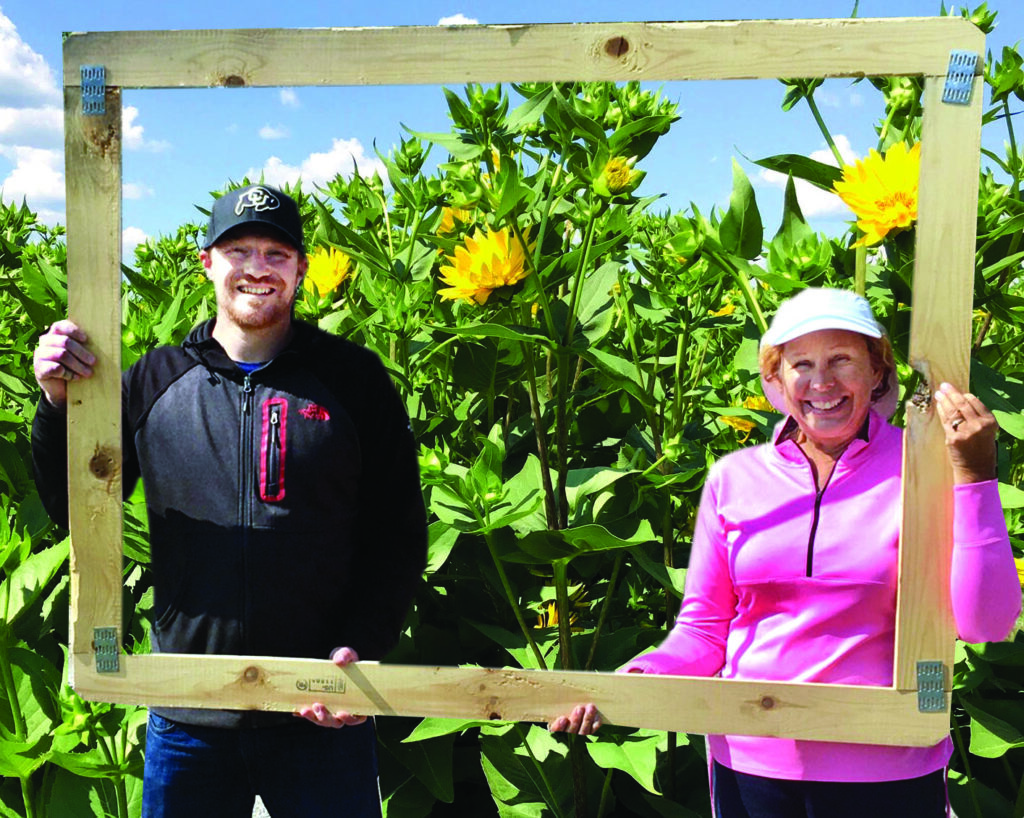
Crop researcher Brent Hulke and sustainability advocate Noreen Thomas envision a future of perennial crops like sunflower and flax that will reduce farmers’ cost and sustain the land.
Nancy Edmonds Hanson
“Perennials are selfish,” plant geneticist Brent Hulke says. “That makes them resilient.”
Unlike commercial sunflowers and flax, the plants he’s growing in experimental plots north and south of Moorhead can’t look forward to a future of being coddled. While farmers coax their domesticated cousins to mature into the oil seeds valued by industry, the tough wild cultivars Brent has planted on the Doubting Thomas Farm near Kragnes and Mark Askegaard’s fields near Comstock are used to fending for themselves – seeking out every advantage to sustain themselves far beyond one growing season.
That could be good news for the region’s agriculture in years to come, he says. “These plants are far more tolerant of temperatures and soil moisture levels than typical crops,” he says. “They have had to adjust to a much wider range of stresses. Their whole mission is to survive.”
Brent is a researcher at the U.S. Department of Agriculture lab in Fargo and professor of crop science at North Dakota State University. Since his stint as a doctoral student at the University of Minnesota, he has followed a dual calling – to develop improved varieties of sunflowers and flax. While the former is heavily populated with other researchers, flax has been more of a personal interest since he began his experiments in 2004 … one that’s almost ready for prime time on the agricultural scene.
Brent’s plots on the Thomas and Askegaard farms are still full of blue, lavender and white blossoms. The offspring of wild plants in the Inter-mountain region from southwest North Dakota through Colorado, Idaho and Nevada, these hardy varieties are nearly ready to come in from the cold. They produce about the same amount of vegetable oil as ordinary annual flax, yet – once established – come up and repeat the process year after year.
Just imagine the advantages. “You don’t have to plant it in the spring,” he explains. “It helps manage water from rain and snow – no run-off or soil erosion. Its roots run at least a couple feet deep, possibly down to wherever the water table is, so moisture can infiltrate the soil better when it’s wet and be brought back when it’s dry.”
The perennials – sunflowers as well as flax – are far more cold-tolerant than cultivars bred for specific micro-climates. “They’re the first out of the frosty ground in spring and the last to go in late fall,” he says, noting that his plants seem to stay green as late as December.
And they’re friendly to the agriculturalist’s wallet. There’s no seed to buy after the first planting, less energy used to plow and plant, fewer hours spent cultivating. “Less cash to get going,” he sums up, “and more free time.”
Brent’s flax plots are recognizable to one who knows Upper Midwest ag. Most bear the same blue flowers, though some with wild roots veer more toward lavender or even white. The plants themselves are bushier, compared to the single stocks of other flax.
His sunflowers, too, look much like their domesticated cousins. The flowers are a little smaller, but there are more of them per stalk. The stalks are equally tall, or even taller. They don’t hang on as late in the season. He has been harvesting the plots in recent days, but not without sneezing: The scientist is slightly allergic.
After the geneticist came to Fargo 13 years ago to work on sunflowers for the USDA, his college-era interest in flax went dormant. Then he learned General Mills was asking his former colleagues at the U of M, “Whatever happened to that flax project?”
“They have a lot of organic food brands like the Larabar snack bar, and they’re looking for special, unique ingredients,” he says. As it happens, the species he’s studying are rich in exactly the kind of healthy ingredients they have in mind. Flax is loaded with Omega 3, essential for heart health, while sunflowers provide Omega 6 and 9 fatty acids. Omega 3 and 6 are essential in the human diet, he explains, but can’t be made by the body.
A native of southern Minnesota, Brent’s work in Clay County is part of a much larger focus on perennial varieties of common annual crops. His funding comes from the USDA’s Sustainable Agriculture Research and Education program. Similar research to develop perennials into sustainable, profitable crops is at other institutions, include the Land Institute in Salina, Kansas, where the new crop called Kernza was developed. Bred from intermediate wheatgrass, the gluten-free alternative to traditional wheat is now available to farmers. Other species being studied are perennial versions of sorghum, gluten-bearing wheat and perennial dry edible beans.
“We’ve made really good progress on perennial flax,” he reports. “A lot of details have to be worked out before the food industry is okay with bringing it on. We need to gather a lot more data, but all the initial data looks very good.” He predicts that perennial sunflowers, which proven more difficult to domesticate, may be ready to be raised for human consumption for human consumption in about a decade.
“There’s a whole group of products right around the corner,” he promises. “They could be really substantial. This could be quite the technological revolution for agriculture.” He adds, “It may reshape our methods of doing business in all kinds of helpful and beneficial ways.”


